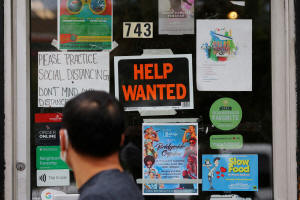U.S. job growth solid in December; wage growth slows
 Send a link to a friend
Send a link to a friend
 [January 07, 2023]
By Lucia Mutikani [January 07, 2023]
By Lucia Mutikani
WASHINGTON (Reuters) - The U.S. economy added jobs at a solid clip in
December, pushing the unemployment rate back to a pre-pandemic low of
3.5% as the labor market remains tight, but Federal Reserve officials
could draw some solace from a moderation in wage gains.
Still, the U.S. central bank's fight against inflation is far from being
won. The Labor Department's closely watched employment report on Friday
also showed household employment increasing by a whopping 717,000 jobs
last month.
Recent declines in household employment had fanned speculation that
nonfarm payrolls, the main measure of employment gains, were overstating
job growth.
The labor market has remained strong, despite the Fed embarking last
March on its fastest interest rate-hiking since the 1980s. It is
underpinning the economy by sustaining consumer spending. But the
economy's resilience raises the risk the Fed could lift its target
interest rate above the 5.1% peak the central bank projected last month
and keep it there for a while.

"The labor market remains resilient but is losing pep and worker
shortages remain intense," said Sal Guatieri, a senior economist at BMO
Capital Markets in Toronto. "While wage growth has moderated, it's still
far from consistent with price stability. Don't look for the Fed to
ratchet down its hawkish talk or slow the pace of rate hikes on February
1."
Nonfarm payrolls increased 223,000 last month. Data for November was
revised lower to show 256,000 jobs added instead of 263,000 as
previously reported. Economists polled by Reuters had forecast payrolls
increasing by 200,000 jobs, with estimates ranging from 130,000 to
350,000.
The economy added 4.5 million jobs in 2022, with employment gains
averaging 375,000 per month.
Employment gains last month were led by the leisure and hospitality
industry, which added 67,000 jobs. Restaurants and bars as well as
amusement parks, gambling and recreation places accounted for the bulk
of the increase in hiring.
Leisure and hospitality payrolls remain 932,000 below their pre-pandemic
level.
Healthcare industry employment increased by 55,000 jobs. Construction
payrolls rose 28,000, despite the house market collapsing under the
weight of higher borrowing costs. Manufacturing employment rose 8,000.
There were also gains in transportation and warehousing payrolls as well
as retail.

[to top of second column] |

A pedestrian passes a "Help Wanted" sign
in the door of a hardware store in Cambridge, Massachusetts, U.S.,
July 8, 2022. REUTERS/Brian Snyder

WAGES SEEN PICKING UP
Government employment rose 3,000, though a strike by 36,000
university employees in California hurt state government education
payrolls which fell 24,000.
Average hourly earnings rose 0.3% after increasing 0.4% in the prior
month. That lowered the year-on-year increase in wages to 4.6% from
4.8% in November. Wages growth could pick up in January as several
states raise their minimum wage and most workers across the country
get cost of living adjustments.
U.S. stocks opened higher on the moderation in wage growth. The
dollar was little changed against a basket of currencies. U.S.
Treasury prices were mixed.
"The market may be rejoicing that wage inflation is slowing, but for
how long if the lowest unemployment rate in history means there is
no one left to employ," said Christopher Rupkey, chief economist at
FWDBONDS in New York. "Higher wages are coming."
Government data this week showed there were 10.458 million job
openings at the end of November, which translated to 1.74 jobs for
every unemployed person.
The average workweek dipped to 34.3 hours from 34.4 hours in
November, which some economists interpreted as a sign that the labor
market was starting to weaken.
The unemployment rate dropped to 3.5% from 3.6% in November. The
decline reflected robust household employment, which offset an
increase in the labor force. The government revised the seasonally
adjusted data for the household survey, from which the unemployment
rate is derived, for the last five years.

The trend in employment growth, however, could slow significantly by
mid-year as expensive credit weighs on consumer spending and
ultimately business investment.
The Fed last year raised its policy rate by 425 basis points from
near zero to a 4.25%-4.50% range, the highest since late 2007. Last
month, it projected at least an additional 75 basis points of hikes
in borrowing costs by the end of 2023.
(Reporting by Lucia Mutikani; Editing by Chizu Nomiyama and Andrea
Ricci)
[© 2023 Thomson Reuters. All rights
reserved.]
This material may not be published,
broadcast, rewritten or redistributed.
Thompson Reuters is solely responsible for this content. |